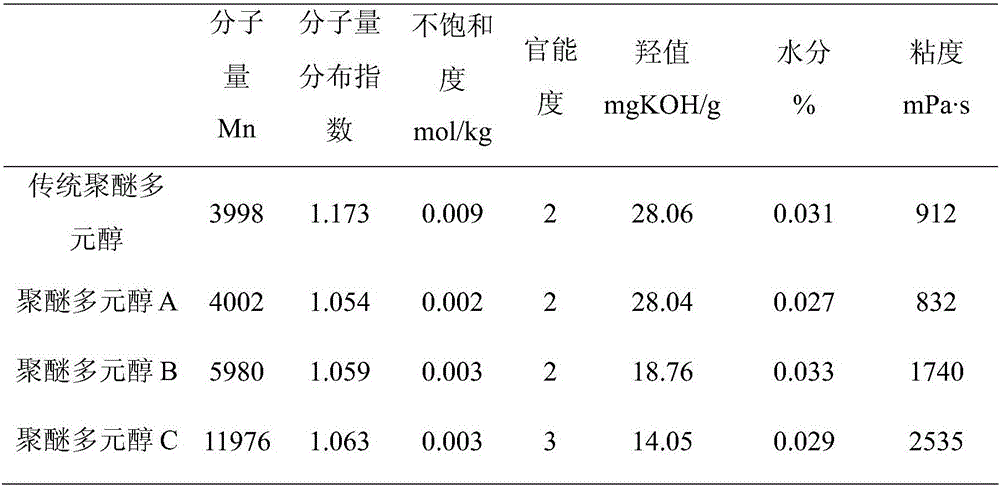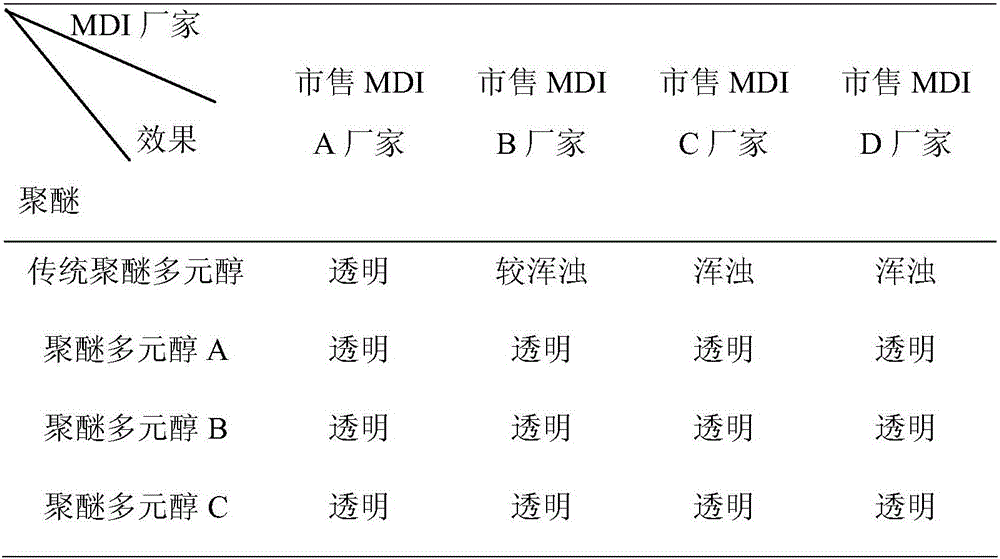Preparation method of low unsaturation degree and high intersolubility high molecular weight polyether polyol
A technology of polyether polyol and high molecular weight, which is applied in the field of preparation of low-unsaturation, high-miscibility, high-molecular-weight polyether polyol, can solve problems such as harsh process requirements, widened molecular distribution, and increased unsaturation, and achieves Effects of narrow molecular weight distribution, reduced regularity, and low degree of unsaturation
- Summary
- Abstract
- Description
- Claims
- Application Information
AI Technical Summary
Problems solved by technology
Method used
Image
Examples
Embodiment 1
[0028] Add 212g DEG and 1.6g potassium hydroxide to the autoclave at room temperature, and replace with nitrogen. After measuring the oxygen content in the autoclave is less than 100ppm, the temperature is raised to 115°C, and nitrogen vacuum (-0.09MPa) is used to dehydrate for 2 hours. Add 588 g of propylene oxide dropwise to maintain the pressure in the reactor at 0.10-0.15 MPa and the reaction temperature at 115°C. After the reaction was completed, the residual monomer was removed under vacuum at -0.09MPa for 1 hour. Cool down to 80°C, add 3.2g of phosphoric acid and 24g of distilled water, stir for 40 minutes, then add 0.4g of magnesium silicate, stir for 40 minutes, vacuum dehydrate at 110-120°C, -0.09MPa for 2 hours, and filter to obtain the intermediate polyether polyol alcohol.
[0029] Add 300g of intermediate polyether polyol and 0.15g of DMC catalyst into the reactor at room temperature, vacuum dehydrate at -0.093MPa and 110°C for 1.5h, then open the external circu...
Embodiment 2
[0031] Add 76g of propylene glycol and 1.5g of potassium hydroxide to the autoclave at room temperature, and replace with nitrogen. After the oxygen content in the autoclave is measured to be less than 100ppm, the temperature is raised to 115°C, and nitrogen vacuum (-0.09MPa) is used to dehydrate for 2 hours. Add 524 g of propylene oxide dropwise to maintain the pressure in the reactor at 0.10-0.15 MPa and the reaction temperature at 115°C. After the reaction was completed, the residual monomer was removed under vacuum at -0.09MPa for 1 hour. Cool down to 80°C, add 3.0g of phosphoric acid and 24g of distilled water, stir for 40 minutes, then add 0.6g of magnesium silicate, stir for 40 minutes, vacuum dehydrate at 110-120°C, -0.09MPa for 2 hours, and filter to obtain the intermediate polyether polyol alcohol.
[0032] Add 480g of intermediate polyether polyol and 0.384g of DMC catalyst into the reactor at room temperature, vacuum dehydrate at -0.093MPa and 110°C for 1.5h, then...
Embodiment 3
[0034] Add 92g of glycerol and 2.4g of potassium hydroxide to the autoclave at room temperature, and replace with nitrogen. After the oxygen content in the autoclave is less than 100ppm, the temperature is raised to 115°C, and nitrogen vacuum (-0.09MPa) is used to dehydrate for 2 hours. Add 708 g of propylene oxide dropwise to maintain the pressure in the reactor at 0.10-0.15 MPa and the reaction temperature at 115°C. After the reaction was completed, the residual monomer was removed under vacuum at -0.09MPa for 1 hour. Cool down to 80°C, add 4.8g of phosphoric acid and 32g of distilled water, stir for 40 minutes, then add 1.6g of magnesium silicate, stir for 40 minutes, vacuum dehydrate at 110-120°C, -0.09MPa for 2 hours, and filter to obtain the intermediate polyether polyol alcohol.
[0035] Add 400g of intermediate polyether polyol and 0.60g of DMC catalyst into the reactor at room temperature, vacuum dehydrate at -0.093MPa and 110°C for 1.5h, then open the external circu...
PUM
 Login to View More
Login to View More Abstract
Description
Claims
Application Information
 Login to View More
Login to View More - R&D
- Intellectual Property
- Life Sciences
- Materials
- Tech Scout
- Unparalleled Data Quality
- Higher Quality Content
- 60% Fewer Hallucinations
Browse by: Latest US Patents, China's latest patents, Technical Efficacy Thesaurus, Application Domain, Technology Topic, Popular Technical Reports.
© 2025 PatSnap. All rights reserved.Legal|Privacy policy|Modern Slavery Act Transparency Statement|Sitemap|About US| Contact US: help@patsnap.com


